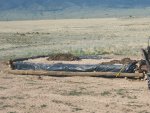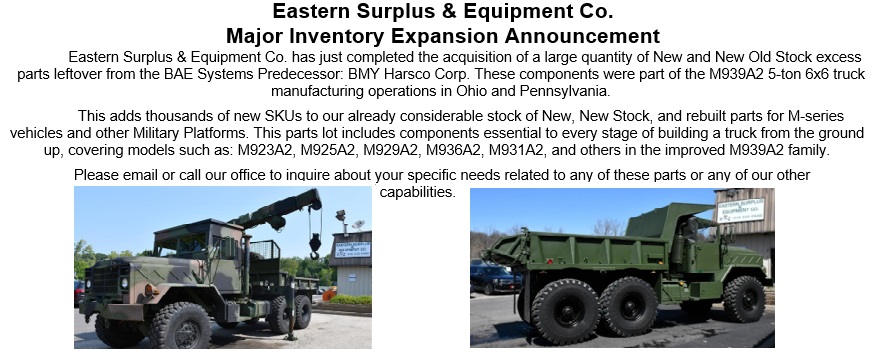- 3,994
- 2,816
- 113
- Location
- Hiawassee, Georgia
Is it possible that the control arm was bent, making it slightly shorter and this is why the holes don't line up? If so, when the control arm was bent that may be what caused the bolt to shear off.
Steel Soldiers now has a few new forums, read more about it at: New Munitions Forums!

It's not bent as far as I can tell. For sure it's not bent enough to make it that short. There is no sign the control arm had fallen down and drug. For sure that would have bent it if it had. There was a stub of the bolt still in the bracket that I suspect held it in place until it was parked.Is it possible that the control arm was bent, making it slightly shorter and this is why the holes don't line up? If so, when the control arm was bent that may be what caused the bolt to shear off.
OK, I guess my question is how do I move the Chassis over, and what caused it to change. I have been searching for any information on the threaded bar that looks like it could spread the frame out, but have not found it in either manual or the parts manual. Does anyone know what it is called?If the rod hasn't changed length, move the chassis over to make the holes line up.
THE quintessential SEE-Whisperer here is hands-down:Hi everyone, it has been a long time.
I have been using my SEE a fair amount lately. The bolt that attaches the front control arm sheered off for some reason. I bought a replacement bolt, but the control arm is too long for the holes to line up. The manual doesn't help, it basically just says put the bolts in and torque them.
View attachment 952657
It's off by probably 5 mm or so. I can get a punch in the hole but can't get it to line up. There is a threaded rod above it that I could try to screw it out, but I am afraid to screw with that, and I'm not sure there is enough travel. I have not found any guidance on that. If I do adjust that, should I leave it wide, or adjust it back to where it was. Any ideas are appreciated.
THE quintessential SEE-Whisperer here is hands-down:
- The FLU farm
Likely he will have an idea for you, rtrask, with his next visit to the site...


You don't need to bother with crawling under a FLU unless you are just curious. I backed off the outer nut and with the help of PB Blaster and a 2' cheater I was able to spread the Chassis Rails enough to install the control arm. I think that is the purpose of the threaded rod, because it has really fine thread for the diameter of the rod. I think my FLU may have had issues with the control arm in the past. I told you the hole the bolt goes through was wallowed out. It looks to me like someone has welded some additional material on the bracket to reinforce it, and that material shows a lot of wear too.Alright, I need to take a peek under a FLU and see what rod you're talking about here. Not a Panhard rod, and not a control arm from what I can tell.
I do think the front tires have excessive toe in, but my FLU will not be going on the highway anytime soon. It should be fine around my property till I can figure it out.The easier task is setting the toe-in. It automatically evens out between the two tires, so don't worry about the right or left tire, but adjust whichever side centers the steering wheel. If the toe is off in the first place that is. Measure it before adjusting anything.
A little too late. I just finished up. I used the threaded rod to spread the Chassis. It was not a big adjustment. I am not sure how I could have used a winch. The problem was the control arm was just a little too long. I could have tried cranking the wheels from side to side. I have looked and looked, and have not found any mention of that threaded rod in the manual.Finally remembered to look, now guessing that it's the lateral rod right above the Panhard rod. Even though you posted an illustration of the Panhard rod.
Oops, reread your post and it seems it's actually the Panhard rod after all (or control arm as they for some odd reason call it) you can't get a bolt through.
If so we're right back to using a winch. Don't overlook that you can move the chassis relative to the axle in either direction, depending on what you hook the winch to. Or try using the steering to shift the axle side to side.
Leave the threaded rod above alone, but I'd probably get new bushings for the Panhard rod before bolting it in if it's been run loose for a while. Although, it's almost more likely that the holes in the bracket took offense and the bushing survived.
A little too late. I just finished up. I used the threaded rod to spread the Chassis. It was not a big adjustment. I am not sure how I could have used a winch. The problem was the control arm was just a little too long. I could have tried cranking the wheels from side to side. I have looked and looked, and have not found any mention of that threaded rod in the manual.
I put a straight edge on the control arm, and to the best of my ability to tell it is straight. The bushings did not look too bad, no worse than any of the others, but I will see if I can source some.



I think that is the purpose of the threaded rod, because it has really fine thread for the diameter of the rod. I think my FLU may have had issues with the control arm in the past. I told you the hole the bolt goes through was wallowed out. It looks to me like someone has welded some additional material on the bracket to reinforce it, and that material shows a lot of wear too.
My guess is that the rod serves as a needed crossmember of sorts, keeping the frame rails from spreading while taking up very little space. And until you weld stout washers, or some other reinforcement, to create round holes again that problem won't go away.
With a winch you can easily move the axle side to side relative to the chassis, and in either direction. That Panhard rod is what positions the axle laterally and there can be quite high forces on it. On some vehicles they're straight, on others there are bends in them, but that doesn't matter. It's the distance between the ends (bolts in this case) that counts and positions the axle where it should be relative to the chassis.I am not sure how I could have used a winch. The problem was the control arm was just a little too long. I could have tried cranking the wheels from side to side.
The list of projects is pretty long. I am continually finding uses for my SEE.Keep us posted, rtrask. Maybe even a pic from one of your projects.



Well, I had already finished before your last post. As I said, it was only off by a few mills so I don't think it is worth while to undo the change I made. It probably would not be too hard to back off the nut on the inside, and then tighten the one on the outside to move it back to where it was. If you really think the small change I made was significant I will give that a shot. I wonder what the tolerance is on positioning the axle relative to the chassis. I suspect that at the slow speeds I operate at, it will not make any difference. Had I gotten your reply prior to starting I would likely have been able to do the job by just jacking the front end off the ground and then a winch would likely not been needed.With a winch you can easily move the axle side to side relative to the chassis, and in either direction. That Panhard rod is what positions the axle laterally and there can be quite high forces on it. On some vehicles they're straight, on others there are bends in them, but that doesn't matter. It's the distance between the ends (bolts in this case) that counts and positions the axle where it should be relative to the chassis.
Basically, the Panhard rod wasn't too long, but the axle had shifted a bit to the right. And why wouldn't it move when nothing was keeping it in place?
Man. That is pretty country that you're in there, rtrask.The list of projects is pretty long. I am continually finding uses for my SEE
View attachment 952851
... The list goes on. It has been a really good investment for me.
That measurement is fixed by distance between the mounts and the length of the Panhard rod. Sure, it varies a little when the suspension compresses and extends, but since it's nearly horizontal in static position the axle's movements are very small.I wonder what the tolerance is on positioning the axle relative to the chassis.
- Prior to that I have been scraping weeds off of the area around my house and the road leading to my house. I have always thought that the front end loader is the weak link in the SEE, but after some practice it seems to work fairly well. It is not a bulldozer, but with the right technique it is quite serviceable.
![DSCN0107[2].JPG DSCN0107[2].JPG](https://www.steelsoldiers.com/data/attachments/708/708180-cf83eac935592c10a7c188ad389cffac.jpg)
We get it, advertisements are annoying!
Sure, ad-blocking software does a great job at blocking ads, but it also blocks useful features of our website like our supporting vendors. Their ads help keep Steel Soldiers going. Please consider disabling your ad blockers for the site. Thanks!

